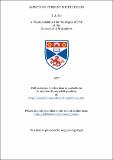Aspects of current sheet theory
Abstract
Current sheets are widely believed to play an important role in astrophysics when regions of magnetic flux are in motion. Several models based on the formation of current sheets have been proposed to explain such phenomena as geomagnetic storms, solar flares and prominences. In this thesis three aspects of current sheet theory are studied with particular reference to the solar flare problem. Firstly the development of two-dimensional current sheets is investigated for several simple configurations. These include converging line current sources, converging and diverging line dipole sources and a dipole of increasing moment situated in either a uniform magnetic field or a constant dipole field. These last two may be thought of as modelling the emergence of bipolar flux from beneath the photosphere, a phenomena frequently observed prior to solar flares. The length, position and shape of the current sheet is determined from the requirement that the magnetic field be frozen-into the plasma. The sheet is found to be curved, except in the symmetrical case of converging line sources. In addition, the extra energy due to the presence of the current sheet is determined. Comparison with estimates of the energy dissipated during a flare indicate that the formation of current sheets may store an adequate amount of preflare magnetic energy, provided no reconnection occurs during the formation process. A three-dimensional axi-symmetric model for current sheet formation is then considered. Two equal and co-directional dipoles approach along the axis of symmetry to form an annular current sheet between them. The equations determining the magnetic field for this configuration are reduced to a single integral equation for the current density in the sheet as a function of radial distance from the axis. A numerical method is used to solve this integral equation. The inner and outer radii of the sheet are then determined from the conditions of flux conservation as for the two-dimensional case. Finally the energetics of a current sheet that forms between newly emerging flux and an ambient field are considered. As more and more flux emerges, so the sheet rises in the solar atmosphere. The various contributions to the thermal energy balance in the sheet are approximated and the resulting equation is solved for the internal temperature of the sheet. It is found that, for certain choices of the ambient magnetic field strength and velocity, the internal temperature increases until, when the sheet reaches some critical height, no neighbouring stable state exists. The temperature then increases rapidly seeking a hotter branch of the solution curve. During this dynamic heating the threshold temperature for the onset of microinstabilities may be attained. It is suggested that this may be a suitable trigger mechanism for the recently proposed "emerging flux" model of a solar flare.
Type
Thesis, PhD Doctor of Philosophy
Collections
Items in the St Andrews Research Repository are protected by copyright, with all rights reserved, unless otherwise indicated.

